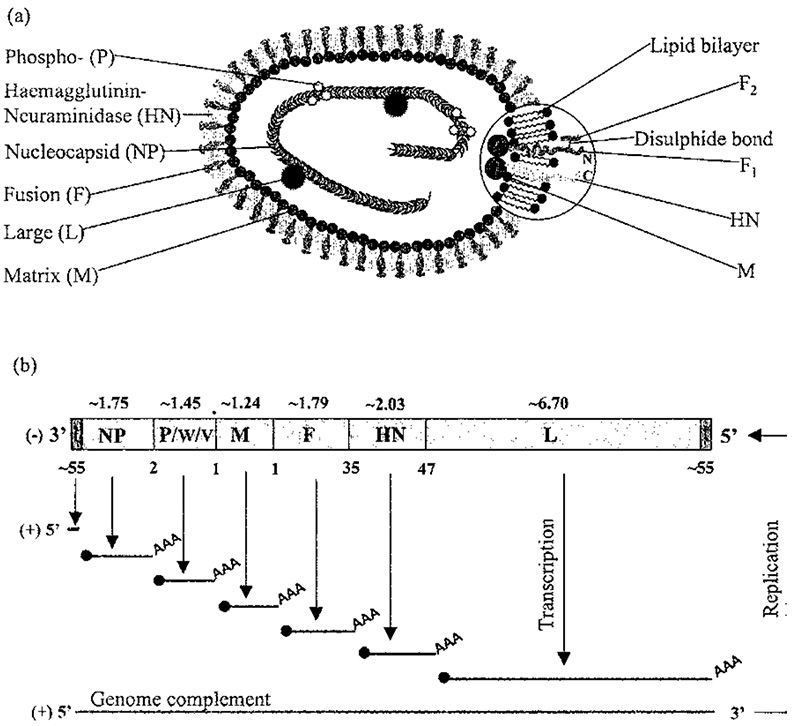Bovine Respiratory Syncytial Virus
Lawrence E. Mathes, Michael K. Axthelm
Bovine respiratory syncytial virus (BRSV) is believed to be a major cause of viral respiratory disease in cattle. The first isolation of a respiratory syncytial virus was from an outbreak of upper respiratory illness in a chimpanzee colony. The human respiratory syncytial virus has subsequently been shown to be a major cause of respiratory disease in infants. Bovine and human respiratory syncytial virus are tentatively grouped with pneumonia virus of the mouse to make up the genus Pneumovirus of the family Paramyxoviridae. Gross lesions from naturally occurring cases are principally found in the respiratory tract and consist of pneumonia characterized by lobular consolidation of primarily anterior lung lobes and interstitial emphysema. In BRSV-challenged gnotobiotic or colostrum-deprived calves, serum neutralizing antibody is detectable by day 6 to 13.
Menangle Virus
Dongyou Liu
Paramyxoviruses are a diverse group of enveloped viruses that infect vertebrates, primarily mammals and birds, as well as reptiles and sh. The family Paramyxoviridae is divided into two subfamilies, Paramyxovirinae and Pneumovirinae, the member species of which can be distinguished on the basis of
ultrastructure, genome organization, sequence re latedness of the encoded proteins, antigenic cross-reactivity, and biological properties of the attachment proteins (presence or absence of hemagglutinating and neuraminidase activities).6,7 Pneumovirinae contains two genera, Pneumovirus and Metapneumovirus, whereas Paramyxovirinae is separated into seven genera, Rubulavirus, Avulavirus, Respirovirus, Aquaparamyxovirus, Ferlavirus, Henipavirus, and Morbillivirus, the type species of which are mumps virus, Newcastle disease virus, Sendai virus, Atlantic salmon paramyxovirus, Fer de Lance paramyxovirus, Hendra virus, and measles virus, respectively.
Human Respiratory Syncytial Virus Infections
Marcello Lanari, Silvia Vandini, Giacomo Faldella
Respiratory syncytial virus (RSV) is a member of the pneumovirus genus and paramyxoviridae family, discovered in 1956. It is an RNA virus with an enveloped, nonsegmented, negative-sense, single-stranded genome with 10 genes encoded for 11 proteins. RSV is the most important cause of acute lower respiratory tract infections (LRTIs) in infants and it is associated with hospitalization and mortality during the first years of life. RSV disease is particularly severe in some groups of high-risk infants, in whom the infection often leads to severe respiratory failure, cardiac complications, and death. RSV infection is one of the most important causes of rehospitalization and respiratory deterioration in preterm infants with chronic lung disease. Clinical manifestations of the RSV infection include both upper respiratory tract infections and LRTIs. Respiratory morbidity of preterm infants increases after an episode of RSV LRTI, with an increase of respiratory symptoms, daycare attendance, hospitalization for respiratory disease, and use of drugs as inhaled bronchodilators.
Avian pneumovirus infection of laying hens: Experimental studies
Published in Avian Pathology
J.K. A. Cook, F. Orthel, M.A. Woods, S.J. Orbell, W. Baxendale, M.B. Huggins
Immunization strategies for the prevention of pneumovirus infections
Published in Expert Review of Vaccines
Nicholas Bennett, John Ellis, Cynthia Bonville, Helene Rosenberg, Joseph Domachowske
Synergy between avian pneumovirus and Ornithobacterium rhinotracheale in turkeys
Published in Avian Pathology
Maja Marien, Annemie Decostere, An Martel, Koen Chiers, Robrecht Froyman, Hans Nauwynck



